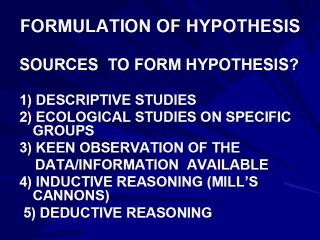| front |1 |2 |3 |4 |5 |6 |7 |8 |9 |10 |11 |12 |13 |14 |15 |16 |17 |18 |19 |20 |21 |22 |23 |24 |25 |26 |27 |28 |29 |30 |31 |32 |33 |34 |35 |36 |37 |38 |39 |40 |review |
 |
Several hypotheses
can be made suspecting the time, place, person variables obtained from
descriptive studies as causes for the disease occurrence or its altered
frequency.
This is the very usual way of getting ideas about hypothesis formation. If one thinks and analyses why a particular disease has occurred at a particular time or place and why it has affected people of certain ages and of certain groups only, then a number of hypotheses will emerge. Ecological studies, the studies conducted on specific groups with specific characteristics, also provide useful information for forming the hypothesis. Examples are that Cancer cervix is rare in Jewish women due to male circumcision and Sickle cell disease is more seen in Indian tribes. |